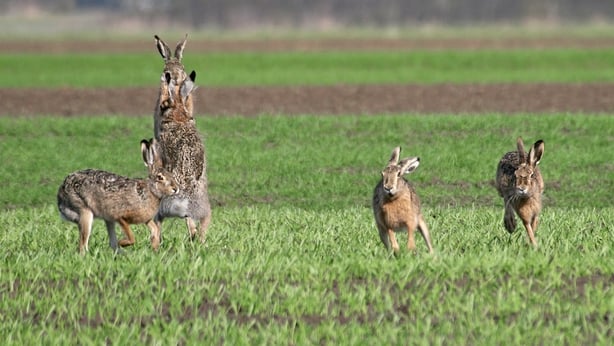Ireland’s oldest mammal, which dates back millennia, is the humble hare.
The months of March and April are peak breeding season for hares – and it’s the bizarre and energetic habits displayed by hares at this time of year that led to the coining of the expression "as mad as a March hare".
They box each other, jump vertically for seemingly no reason and generally display abnormal behaviour – a wonderful sight if you’ve ever been lucky enough to encounter it.
Though hare populations do fluctuate naturally, there has been a marked decline in the numbers of this long-legged animal in the past 50 years.
Though it's not entirely clear why, one consequence is that it's become harder to observe their exuberant activities in the wild.
But now we know why the animals seem to go mad during mating season.
"Originally it was thought that it was the males boxing off other males looking for females, but it was then discovered that it was actually the females boxing the males", said Dr Karina Dingerkus, an ecologist who specialises in the Irish hare.
"The females are dominant, and they tend to be a small bit larger than the males, which is unusual", she said.
"The boxing is the females trying to get rid of the males they don’t want."
"Perhaps she doesn’t want that male, perhaps she’s looking for a stronger male or it might just be that she can’t be bothered at that moment."

Hares are found in any habitat. As long as there’s some form of cover – from rushes and hedgerows to tall vegetation on the edge of woodland areas – there will be hares.
Because they don’t burrow like rabbits, they need somewhere to shelter during bad weather. Hares are also much larger than rabbits: When you see them moving, the telltale sign is that, rather than hopping, they will almost lope, like a greyhound.
Changes to agricultural practices are one reason for dwindling populations of these animals: the disappearance of hay meadows and the cutting of silage earlier in the year have impacted the eating habits of the animals, which need a varied diet.
"The monocultures of ryegrass – which is what tends to be grown by farmers for feeding cattle – is not good for them", Dingerkus said.
The greatest predator for the hare is the fox, but roadkill is also having an impact on hare populations.
The National Parks and Wildlife Service has commissioned Queen's University Belfast to determine population levels across the country.
But efforts to forge better habitats for hares would likely have the biggest impact on numbers in the wild, Dingerkus said. We need less mowing and more hay meadows, and less intensive use of pesticides.
"There are ways that farmers can manage their farms that are more biodiversity-friendly", said Dingerkus.
Maybe then it’ll be easier to catch sight of the almost mesmerising mating dances of the March hare.
For more, go to the Mooney Goes Wild show on RTÉ Radio 1.


